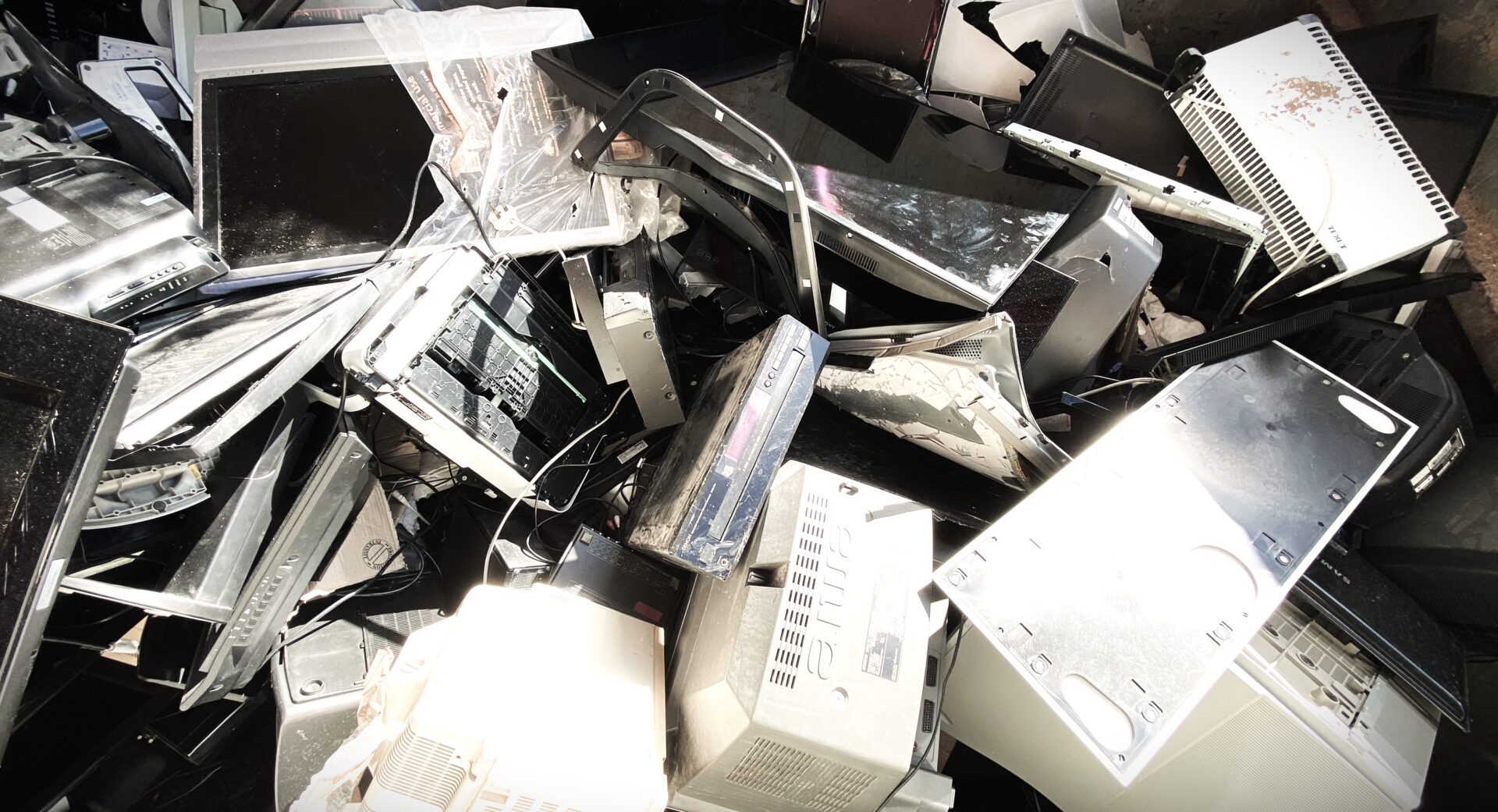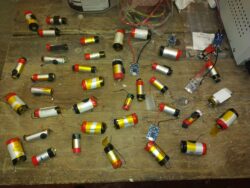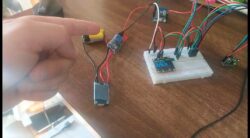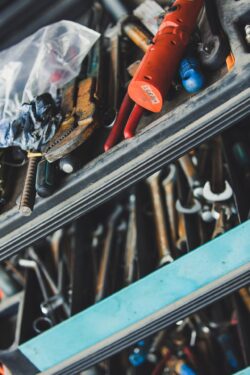From Trash to Treasure: The Art of Recycling Household Technology

By Volodymyr (Vlad) Chapman
What is the LIDA Upcycle / Recycle initiative?
The initiative is a local take on Community Repair Cafes - fixing broken technology, repurposing old / unneeded tech and raising money for community causes.
Motivation
An accidental hobby of mine is self-sufficiency. Accidental because, previously, I would have happily paid full price for the things I wanted – a gaming PC, twice annual oil changes for the auto, frequent Italian thin crust pizza – but I didn’t have (nor will I ever have) the money for all the things that I want to be done by someone else.
The gradual realisation, mostly through YouTube, that most of these things are actually quite cheap and simple to make fed this kernel of self-reliance from a youthful necessity to an oak tree of mistrust towards the service industry at large. Costs appear to be dreamed up. I don’t know why a Latte costs £3 when the raw ingredients cost nearer to 25 pence (a 227g bag of coffee grounds makes around 15 regular cups using a stove pot); why a pizza made of flour, cheese and tomato paste costs £10 or why custom PC builders charge £5 to install Google Chrome.
 Short of putting on a foil hat (self-assembled for a fraction of the price), I would go so far as to say that dependence and a sense of helplessness are actively nurtured as a part of successful business. Sprinkled with ceremony and obfuscation, many products and tasks have been made to appear much more complicated, and costly, than they are.
Short of putting on a foil hat (self-assembled for a fraction of the price), I would go so far as to say that dependence and a sense of helplessness are actively nurtured as a part of successful business. Sprinkled with ceremony and obfuscation, many products and tasks have been made to appear much more complicated, and costly, than they are.
Seeing through this is the key to a happier and more cost-effective lifestyle – a trainer is simply a rubber sole glued to a fabric body; a washing machine is a motor that spins a drum with a rubber belt, a water pump and a heating element to heat the water; chess pieces are sanded wood. The magic isn’t in the awe of the mystery of the items we own but in hearing a squeak in our headphones and knowing that they just need a clean. Understanding is bliss.
Alongside this aura of mystery surrounding technology, we have our manufacturing inequality. Raw materials are standardised and minimal brain power is required to assemble these into an end product. Repair, on the other hand, has a range of starting points and needs processing power. For example, a machine can assemble a Hoover but it takes the critical thinking of a human to process the initial state, the deviation from the desired state and the appropriate actions to fix a broken one. Manufacture is therefore infinitely more scalable than repair and can employ a cheap labour force – machines. It is often cheaper to buy something anew than to fix. This is unfortunate for two reasons.
Firstly, the environmental impact of the unfixed items. In the UK, we dispose of 440,000 to 500,000 metric tonnes of e-waste a year (Statista, 2023), 22% of which can be described as large electronics (BBC, 2020). Where do we store this immense volume of non-biodegradable junk? It’s a choice of whether we prefer to bury hectares of glass, metal and expensive trace elements; burn all those plastic cases or have turtles ensnared by ethernet cables and Nan’s old iPad… neither of which is ideal. Secondly, it breeds a throwaway culture through ‘perceived’ high cost of repair. Even if a particular type of repair is cheap and easy to do at home, the cost can be assumed to be high simply because many repairs are expensive.

In times of plenty, I can understand corporations wanting higher profits. In a cost of living crisis succeeding a pandemic during a European war, nestled just before an environmental catastrophe, I would hope that industries support consumers in making more cost- and environment-conscious decisions. It would be nice to see Primark offering discounts for trade in clothing; Ikea opening a ‘pre-loved’ section or Microsoft expanding Windows 11 support to older processors (currently only supporting those from 2017 onwards).
I cannot stress enough the environmental impact that even one of these initiatives could have.
The European Union has taken a firm stance in enforcing green policies on tech manufacturers. Some of these are in the standardisation of charging cables (BBC, 2021), with last generation cables having contributed quite a bit to e-waste* and enforcement of removable batteries (euronews, 2023), a leading cause of upgrading to newer phones*. With luck, such rules will be extended to the other leading causes of tech replacement: phone screens, laptop batteries and laptop hard drives.
These two factors – lifting the veil of mystery behind repair to inspire more make-do-and-menders and the environmental impact of e-waste - were ultimately the inspirations for the Upcycle / Recycle initiative.
How has it been received?
The reception within LIDA has been phenomenal. Donations have rained in from the LIDA community and even a few surprise items from family.
In total, there have been five smartphones, a smartwatch, three laptops and a Gigabit switch (Image 1). These are all in repair / refurbishment with sales for charity scheduled for a break in PhD hostilities (hopefully Late October).
Image 1: Box of LIDA upcycle / recycle donations, including 5 smartphones, a smart watch and 3 laptops

On another front, wandering dimly-lit streets in search of castaway vapes has proved a lucrative venture. The batteries inside of these little bubble sticks are perfectly rechargeable and offer a world of opportunity when twinned with a microcontroller (a basic form of computer ideal for defined, low computation tasks). Close to 40 vape batteries have now been collected (Image 2).

Image 2: A sea of vape batteries rescued from the streets. Seeking good forever homes in Arduino projects.
The batteries are slowly being put to use on a range of tasks, including as the power source for a (not yet so mobile) squash accelerometer (Image 3; in collaboration with Will Boulton, a super human being and PhD student at the University of East Anglia).
 Image 3: A squash accelerometer prototype (for tracking power and fatigue during a squash game), powered by a former vape battery. A collaboration with Will Boulton, PhD student at the UEA.
Image 3: A squash accelerometer prototype (for tracking power and fatigue during a squash game), powered by a former vape battery. A collaboration with Will Boulton, PhD student at the UEA.
The repair front has also been busy with the following:
- Singing Christmas Toy – the official mascot of LIDA admin staff suffered corrosion of the electrodes meaning that their batteries no longer formed a connection with the cheer circuit. A quick clean of the corrosion has ensured joy for many more winters.
- Beats Studio 3 – a £350 pair of headphones unusable after snapping of the plastic headband, caused by normal wear and tear. Easily fixed with a £15 replacement headband.
- Dell XPS 15 7590 – a £1,000+ laptop suffering a second severe motherboard malfunction in under two years of normal usage. This one has had me stumped for a while but the issue has been isolated to the GPU power rails. Progress is slow at the motherboard level. I’m still hopeful that replacement of a few 10 pence motherboard components could save this device from the scrapyard.
Future of Upcycle / Recycle:
The response to the initiative has been uplifting – LIDA members have been open to the idea of having devices fixed and have been immensely generous with donations. I am optimistic that this is a sign that members of our community will continue to use repair cafes within Leeds following the end of this iteration of the LIDA Upcycle / Recycle initiative (my PhD is finally coming to an end). I hope that others will approach old and broken things with a new mindset, too – patience, research and YouTube videos are the keys to repairing the vast majority of household tech. The greatest danger in learning to repair tech, as with most skills, is in trying to start with something much too complex, becoming overwhelmed and losing motivation. The secret is to start with small, simple projects and gradually increase complexity in repair. Some great starter projects would be to learn to:
- refill printer cartridges. This doesn’t work with every printer manufacturer but a fair few allow for cartridges to be refilled (a printer cartridge refill kit with 50+ refills of ink costs about half the price of a single cartridge on eBay)
- Install Ubuntu on an old laptop. Linux operating systems generally work really well on old laptops as they consume fewer computational resources than Windows. Ubuntu Desktop is a feature rich operating system designed to be beginner-friendly.
- Make an old hard drive portable. Old hard drives from laptops can be converted into external hard drives cheaply and easily with conversion kits – about £5 on eBay. A great alternative to buying one new.
- Learn to solder with a soldering practice kit. There’s a bit of a steep learning curve but, for those ready to perform board surgery, SMD practice kits cost between £3-£7. They’re a great way to learn to not burn yourself (too much) with a soldering iron and sometimes even solder micro components.
There are dozens of YouTube videos for each of the above.
What would I recommend for new fixers?
 My safety glasses, 122 in 1 precision screwdriver set and silicone repair mat (all between £5 and £10 on eBay) are the only essential pieces of equipment. A heat station, soldering iron and BIOS reprogrammer may become necessary for more complex repairs.
My safety glasses, 122 in 1 precision screwdriver set and silicone repair mat (all between £5 and £10 on eBay) are the only essential pieces of equipment. A heat station, soldering iron and BIOS reprogrammer may become necessary for more complex repairs.
For computer components (i.e. hard drives, solid state drives, RAM sticks, graphics cards etc.), my go-to shop is CEX. Though their prices are sometimes more expensive than eBay, the 24 month warranty on all of their goods has saved me a lot of money in the long run, especially with hard drives.
For repair guides, I rarely venture far from www.ifixit.com and YouTube. Only in the case of very obscure problems (replacing corrupted BIOS on network attached storage units) have I had to resort to forums and customer support threads.
Oh, and for repairs of anything attached to the mains, I’d turn the mains electricity off at the breaker and make absolutely sure to cross-reference the information across multiple sources. It’s best to stay away from anything with a large capacitor (microwaves & TVs) until absolutely sure how to safely discharge them.
* : In my humble assessment, given my experience.
 Volodymyr (Vlad) is a final year PhD student developing AI methods for pathology image analysis. He gets overly excited by computer hardware, modern fiction (Atwood, Marquez, Saunders et al.) and pine forests.
Volodymyr (Vlad) is a final year PhD student developing AI methods for pathology image analysis. He gets overly excited by computer hardware, modern fiction (Atwood, Marquez, Saunders et al.) and pine forests.
His dream is to retire to the Carpathians, young, and fill the rest of his days with abstract projects that annoy the better half but amuse the kids.
References:
BBC (2020) Can we fix our way out of the growing e-waste problem? Available at: https://www.bbc.co.uk/news/business-51385344
BBC (2021) EU rules to force USB-C chargers for all phones. Available at: https://www.bbc.co.uk/news/technology-58665809
euronews (2023) New EU law to force smartphone makers to build easily replaceable batteries. Available at: https://www.euronews.com/green/2023/06/22/new-eu-law-to-force-smartphone-makers-to-build-easily-replaceable-batteries
Statista (2023) Quarterly household WEEE collected in the United Kingdom (UK) from 1st quarter 2013 to 4th quarter 2022. Available at: https://www.statista.com/statistics/517657/household-ewaste-united-kingdom-uk/
